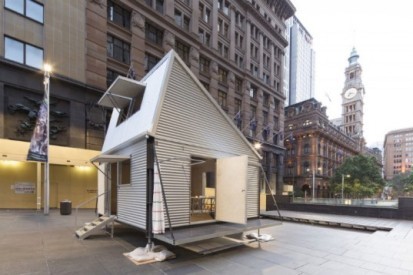Shaun Carter, principal architect at carterwilliamson architects, has been in private practice since 2001.
As part of the Sydney Architecture g=festival, caterwilliamson's GRID, a flat-packed, transportable house was exhibited in Martin Place.
Architecture & Design spoke to Carter about GRID, how architects can give back to communities and why being a structural engineer has helped his design.
Can you tell A&D about Grid?
GRID, named after the Norse Goddess of peace, is a lightweight, flat-packed emergency dwelling that is adaptable to almost any climate or terrain. GRID is designed as a medium-term shelter for communities devastated by disaster or war, acting as a second wave response that arrives after tents and before permanent rebuilding. Once it is no longer required GRID can be packed down and re-deployed for use elsewhere. The inverted Acrow props legs and flat-packed, standardised elements allow GRID to be erected by unskilled labourers in just a few hours.
GRID gives us the opportunity to use our skills as architects to give back to communities in need.
 GRID image courtesy carterwilliamson, photo by Brett Boardman.
GRID image courtesy carterwilliamson, photo by Brett Boardman.
Where did the idea come from?
The idea for GRID came from the Indian Ocean Tsunami of 2004. I had a friend living and working in Sri Lanka. He woke to find a boat nearly on his doorstep. He lived 1km from the ocean. He knew something was wrong.
A week after the tsunami I heard he was okay, but my initial intense interest continued and I watched as tents and the first wave of response arrived to house the displaced. Many months later, nothing more permanent had been provided, no shelter that might lift people up and off the ground and provide safety and security, allowing people to re-group and rebuild their lives. Waterborne disease is the second great killer after initial disaster and leaving people on the ground in tents makes them especially vulnerable.

The challenges and constraints of developing a response to this type of disaster situation were vast, but not unfamiliar, and architects generally concur that the greater the challenge the more exciting the design solution and it proved so with GRID. We believe GRID can walk the middle ground between short-term accommodation and permanent housing and will help solve many of the problems facing universal deployment of medium-term shelter in disaster response.

You were previously a structural engineer. How has that past experience informed your design today?
I'm sure it helps. Structure for me is fairly intuitive so it seems something has sunk in over that time. I see it as knowing the rules and once rules are known, you know how to break them. It takes structure out of the way and makes it a participant in the creativity of design rather than a hindrance. It also shows you a way of critical thinking that is invaluable, not only in architecture, but life. It has served me well. I wouldn't have it any other way.
What is the greatest challenge facing the design industry today?
The greatest challenges the design industry faces, particularly here in Australia are undervaluing design and design ignorance. Australian's are a pragmatic people that value what is real and tangible. Design exists initially as 'unreal' and sometimes intangible. You can't hold or touch it and sometimes I find we, as a gross generalisation, are sceptical about something like that. In the cities this mindset is changing fast. Melbourne and Brisbane particularly are leading the charge. Sydney is following slowly behind.
Local councils are the approval body for most architectural work. Some councils, like the City of Sydney are enlightened and embrace design as a way of revitalising the city. Other councils, like Ashfield and Leichhardt in Sydney, are desperately under-skilled in reading and understanding architecture. They don't understand their built environment very well, are lost in imagery and pastiches of older styles and use heritage as their trojan horse to discredit good design. With their limited skills and understanding mediocrity is the best outcome they can hope for. It's a shame.
What are some solutions?
Solutions to these challenges are easy: education and leadership. But both require cultural change for this to occur. I am hopeful the Barry O'Farrell government will reform planning sufficiently to allow design to be the important consideration it needs to be.
What project are you most proud of?
Probably the Opera House. It's remarkable that this amazing building had the wisdom and support to be built in this state.
If you are referring to carterwilliamson's work, again there are many, but most of all I am proud of the process that we have developed. I am proud of the clients and builders that we have been fortunate enough to work with. I truly believe that you are the company you keep.
Images by carterwilliamson.

